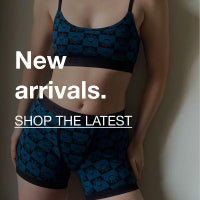Size: 3 Reasons Why It Can Make or Break an Outfit

Today’s word of the day is size:
We know it’s pronounced saɪz, we know the definition of size, and we could guess at some synonyms you might find on a thesaurus’s word list. But for everything we know, the most important thing is how it feels when you find an item of clothing that fits just right.
All of us have had the sensational experience of finding a pair of jeans that fit like a glove. They hug you in just the right way, showcasing what’s most beautiful about your figure. They give you a boost of confidence that adds some sass to your walk. And when you notice that all eyes are on you, you know it’s for the right reason.
Still, we’ve probably all had the unfortunate experience of trying on clothes that just don’t feel right. Maybe your shirt bunches up in an awkward way. Perhaps your slacks don’t quite fit at the waist, leaving an uncomfortable gap in that a belt bunches up. It makes you wonder if people around you notice your slight wardrobe malfunction. Even though they probably don’t, it still doesn’t feel great.
Even though our clothes aren’t always the perfect, custom size, sometimes we need to resize our apparel. So, let’s talk about why size can make or break an outfit.
1. Size and Fabric Are Related
No two humans are the same shape or body size. Even though we can’t all have our clothes expertly tailored to our forms, designers try their best to make a wide range of fits for everybody and every body.
There are tons of dimensions to account for when sizing an article of clothing as simple as a t-shirt. One way brands make it easier to find the right ‘fit is by tailoring their sizing to their target market.
A brand’s target market is going to determine what kind of people are likely to wear their products. From the designs they create to the fabrics they use, clothing brands consider their target markets’ needs every step of the way — size included.
With the growing spotlight on shape and body inclusivity, many brands have gone to great lengths to make it a part of their mission to create an extensive selection of sizes. As that selection pool becomes more representative of the actual diversity across the globe, it gives people the opportunity to find the clothes that fit them in a way that best flatters their figure.
2. The Right Sizes Makes Us Feel Confident
The short answer is yes! There’s a high degree of intentionality when designers create the dimensions for each garment. They know what body type they’re creating each product to fit.
They use the right amount and type of fabric. They’re specific about stitchings. They use a particular kind of fabric that is going to have the elasticity or stiffness to create the look they have in mind — but if you pick the wrong size, it can throw all of those things off.
Clothing is meant to work with you, not against you. That’s why it’s essential to make sure your clothes fit you the way designers mean for them to fit. You can do yourself the service of choosing clothes that truly make you feel most beautiful.
3. Size Charts Can Affect the Outfit
While we may have a general idea of what our size is, it can sometimes differ from brand to brand. According to a survey from TODAY, more than 70% percent of people have noticed that inconsistency.
Someone may wear a small size in one brand’s products but may be extra-small in another’s. This probably contributes to people wearing the wrong size since they may gravitate towards the size they’re used to, not the one that actually fits.
After doing some research, some find that almost 80 percent of AFAB people don’t wear the right clothing size. One of the people a part of this study admitted that they intentionally bought the wrong size because they wanted to hide what they perceived as their body’s imperfections.
After trying on clothes that fit them the way they’re meant to, they found that they did feel more confident and comfortable. This shows the greater truth about clothing. Properly fitting clothes are not your enemy — they’re your best friend and biggest hype person.
How Do We Know If Our Clothes Fit?
With every kind of clothing, there are going to be telltale signs that will tell you if your clothes don’t fit you the way they should. Keep in mind that there are exceptions when you’re intentionally dressing for the oversized trend that has been popular for some years.
Shirts
For your shirts, one indicator is that your sleeves either reach past your knuckles or don’t reach your wrist. If you’re wearing a button-down shirt, you shouldn’t be drowning in it, but it shouldn’t be so tight that the shirt creates an X shape from the fabric pulling.
In general, the stitching that runs along your shoulders should measure to be no longer and no shorter than the width of your shoulders.
Pants
Here are a couple of tips for your pants: When you stand, your pants generally shouldn’t show your socks. However, this general guideline doesn’t apply to specific fashion trends like cuffed jeans that showcase crew socks.
One more sign that your pants don’t fit well is that your pant pockets stick out. When this happens, your pants are too tight, and you may want to consider a larger size to prevent rips.
Shoes
Wearing the right shoe size is just as important. Normally, you want there to be about a finger’s width of space between your big toe (or your longest toe) and the front of the shoe. You can also check for the same amount of space in between your heel and the back of the shoe.
In general, be aware of how you feel in your clothing. If it’s difficult for you to move your limbs however you normally would, it likely doesn’t fit. We suggest trying on clothes and making exaggerated movements to be sure. And definitely make sure to try sitting down and standing back up. Check that nothing bunches up or swallows your figure entirely, either.
Size Charts Can Affect the Outfit
When you’re shopping online, and you can’t physically see which particular size works for you, brands will almost always provide a sizing chart. Still, for the chart to be helpful, you need to know how to measure yourself correctly.
The most common measurements charts ask for are for your chest, waist, hips, and inseam. You’ll want to use a soft tape measure and use the numbers you get when the tape measure is snug around each area. Don’t measure too tightly, or the clothes will likely be too small.
Be sure to read any reviews customers leave on their product description page. They’ll probably comment on the product’s size, whether it runs big or small or if it’s true to their size chart. Sometimes customers even post pictures of themselves in the product and say what size product they’re wearing. This will give you a good idea of how different sizes fit on a variety of body shapes.
(There are also apps available for Apple and Android that can help with finding your measurements.)
TomboyX
TomboyX prides ourselves on designing apparel that is inclusive of people of all sizes. One way we do this is by fit-testing our products on all body types and providing a larger selection of sizes. Some of our products even range in size from XS to 6X.
Because TomboyX knows that we are all diverse in body shapes and sizes, we even create fit guide charts for all of our products that show how each is supposed to feel on your body. With our brand, you can pick out your favorite products, knowing they’ll fit you and complement your vibe.
Knowing how to find your size — and choosing to wear it — will transform both your shopping experience and your relationship with your wardrobe. So, it’s time to update your wardrobe wishlist. When you do, you’ll find out that it’s true; size can make or break an outfit.
Sources:
71 percent of TODAY viewers say clothing sizes don't make sense | TODAY
Staggering Number Of Women Wearing Wrong-Size Clothing | ABC






